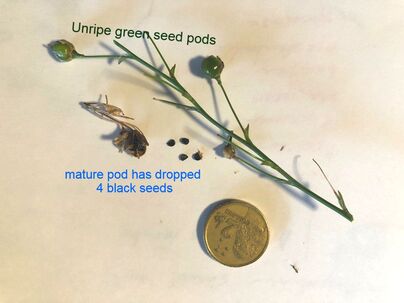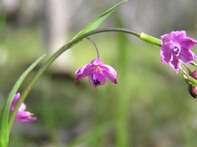Recreating the Country blog |
|
- becoming wild in isolation  There's a good reason to get down on your hands and knees to become acquainted with some Australian native plants There's a good reason to get down on your hands and knees to become acquainted with some Australian native plants Have you ever wished you had the time to learn more about your local wild plants? They’re a beautiful part of our natural heritage and they’ve been growing on our landscapes for a very very long time. Usually the task of learning the tricky unpronounceable scientific names is enough to put most people off. I’d like to help you discover some of these amazing local plants one plant at a time. And you’ll have a whole week to learn each plant name and some of its hidden secrets. Then you can impress your friends (yes, there are much better reasons to know them I agree) and it could well become the catalyst for new outdoor experiences. I’ll throw in translations of the ancient Greek/Latin names as a bonus. This will often help you with identification, though its usually the very subtle features that botanists choose to recognise in the scientific name, as you will read. Plus you’ll learn some quirky things that you won’t believe about these plants. This will help cement your new knowledge and your isolation will begin to overflow with possibilities. The world of wild plants will open to you and you’ll be keen to explore your wilderness areas next spring when the wildflower season begins. This month is botanical names starting with A – there will be one new incredible plant each week.  Chocolate Lily, Arthropodium strictum Our first amazing plant is ideal for Easter celebrations. The reason why may surprise you. It's a small lily that’s perfect for rockeries and small patches in the home garden. Plant 20 + in a large patch for an amazing scented display. It has a mauve six-petal star-shaped flower the size of a $2 coin  Its all Greek to me - not quite! Its scientific name comes from two ancient Greek words and one Latin word Greek - Arthron = joint (arthritis is joint pain); podos = foot (athletes place their feet on a podium when they win an Olympic medal). So the botanist who named this plant thought its flower stork was like a jointed foot. I don’t see it myself but there it is. Latin – strictus = rigid. This is easier to see on the plant because it has a very stiff upright flower stem that stretches to 30cm and sometimes much taller. To pronounce the scientific name, think of arthritis & podium and run them together. Already you’re sounding like a professional botanist. Don’t be too strict, um because no one really knows how to pronounce these words - there’s no official protocol. The Dja Dja Wurrung name for Chocolate Lily and Vanilla Lily is Gitjawil matom. (Su Hauck pers com. - see Su's comment on 22/12/21 below for more information) Nature notes Chocolate lily's flower colour and rich sweet scent is a magnet for native bees, moths and butterflies. It will also bring them into your home garden if you plant a patch. You'll see it growing in native grasslands and open areas in woodlands and forest where there is full sunlight or dappled shade. It complements and enriches the ground habitat and is found with other lilies, native grasses, native herbs and orchids. We have a very rich and wonderful heritage in all these plants.  Can you imagine a wild place where the air smells like chocolate? Can you imagine a wild place where the air smells like chocolate? Some human context The Chocolate Lily is a member of the Asparagus family, which fits well with its use as a raw or roasted root vegetable used by the First Australians. Though it’s not the root but its edible flower that has a chocolate scent. To read more about its food use click here I have a friend who was a child during the Second World War. At that time most things were in short supply, especially chocolate bars. She would stop on her way home from school in spring and smell the Chocolate Lilies growing on the roadside. She could imagine the wonderful taste of chocolate with each new drift of flowers. Chocolate Lilies are widespread throughout Australia and their flowers appear from September through to January. In my home garden they flower well into April.  Seed pods and mature seeds of the Chocolate Lily. (Click on the image to see more detail) Seed pods and mature seeds of the Chocolate Lily. (Click on the image to see more detail) ...and they're easy to propagate Simply push the small black seeds into seed sowing mix any time from spring through to late summer and their single leaf will appear within four weeks. When they are large enough to hold with your thumb and forefinger, transplant into pots to grow on for the garden. Plant into your garden in late winter to early spring. It likes a sunny well drained position. Be prepared to be delighted for many months and of course children love the chocolate scent. Where to get seeds and plants Seeds and more useful info on propagation are available at this link Contact your local Landcare group for sources of plants and seeds;
Contact your local Native Australian Plants Society for sources of plants and seeds Do you have a Chocolate Lily story that you'd like to share? Close relatives  Photo: David Bruce Photo: David Bruce Nodding Chocolate Lily, Arthropodium fimbriatum - from Latin fimbriae=border or fringe. It has a frilly fringe on its chocolate scented petals (click on photo to see the fringe). This lily can grow up to over 0.8m tall. Flowering is from September to January  Pale Vanilla-lily, Arthropodium milleflorum - as you will have guessed, this lily has a vanilla scent - from Latin mille=thousand & florum=flowers. This beautiful plant smells of vanilla and has prolific clusters of flowers (though significantly less than a thousand - even botanists sometimes exaggerate). This lily grows to 1.3m tall. Flowering is from November to February Small Vanilla Lily, Arthropodium minus from Latin minor=smaller. It's quite demure and only grows to 0.3m tall. Flowering is from August to December Next week another is botanical name beginning with A. Berry or Creeping Saltbush; Atriplex semibaccata - the living mulch plant with edible fruit
25 Comments
Kate Simpson
16/4/2020 09:36:10 pm
Thank you for this fabulous educational challenge - exactly what I've been looking for.
Reply
Steve
17/4/2020 09:04:16 am
Thanks Kate, We'll walk together through some of Australia's wonderful floral heritage at a comfortable pace to enjoy all that it has to offer
Reply
Fran
17/4/2020 08:48:43 am
I don't think I've ever smelt the chocolate but they are a pretty flower. I look forward to learning more about our native plants and might even be able to outdo Stuart with their botanical names :-)
Reply
Steve
17/4/2020 09:10:21 am
Hi Fran,
Reply
Stephen D
10/1/2022 04:57:13 pm
Hi Steve - I have some seeds for NODDING CHOCOLATE-LILY (Arthropodium fimbriatum) - given what you've mentioned above about scent filling the air, I assume the dogs and maybe even the cats might be attracted to them. Do you know if they are safe for pets?
Christine Brooks
19/4/2020 01:05:56 pm
They seem to be hardy. We have some in a secluded park next to Ocean Grove Nature Reserve. Council mows right over them, but they come back.
Reply
Steve
20/4/2020 09:12:16 am
Hi Christine,
Reply
Christine Brooks
20/4/2020 12:40:44 pm
Thanks Steve!
Glen White
21/4/2020 09:54:24 am
Hi Steve What a great idea. Thank you! My favourite Chocolate Lily stories involve seeing the look on the faces of children smelling them for the first time (and some adults too!) I like your challenge of learning botanical names - having some knowledge of them can inform one of relationships & add to seeing the 'bigger picture' of plants. Coincidentally I have set myself the task during lockdown to learn/relearn about individual birds, including their scientific names. Magpies are getting a workover at the moment - and they are one of the birds that have changed scientific names in the recent past, just to keep everyday birders on their toes. Thanks again for the great blog. Glen
Reply
Steve
23/4/2020 03:46:59 pm
Hi Glen,
Reply
Phil Hunter
28/4/2020 08:58:36 pm
Hi Steve,
Reply
Steve
30/4/2020 10:16:39 am
Thanks Phil,
Reply
Jim Elvey
11/5/2020 03:08:09 pm
Thanks Steve for this great piece about chocolate lilies. We are blessed on our small, never farmed open woodland block to host a lot of wildflowers. Most predominant is the Chocolate Lily. We wait until they have nearly finished flowering each year (by which time we thinking about fire hazard reduction) to mow over them. It appears to us over many years that careful mowing fosters their growth and perhaps suppresses invasive grasses. Not as good as burning perhaps, but not something to be afraid of doing either.
Reply
Steve
14/5/2020 12:05:39 pm
Good to hear from you Jim,
Reply
Su Hauck
25/11/2021 06:19:57 am
Hi Jim. I've had a lot of chocolate lilies on my property, to my great delight and have avoided mowing up until now. Can you tell me about correct mowing. I would probably just mow close to the house. I'm also wondering what the indigenous name is for these, if anyone knows it. I would really love to know that!
Reply
Steve
10/12/2021 03:02:54 pm
Hi Su,
Su Hauck
12/12/2021 06:51:26 am
Hey Steve, Thank you.
Irene Kelly
23/5/2020 04:36:35 pm
Thanks so much Steve for this great article. Really enjoyed it. I am a volunteer with an urban indigenous plant nursery and love these lovely plants.
Reply
Steve
1/6/2020 09:59:55 am
Great to hear from you Irene,
Reply
Susan Cahill
22/9/2020 06:57:12 pm
I am currently camping in the Weddin Mountains in the Holy camp site, and I have discovered the chocolate lily again! As a child growing up not far from here, my mother first shared these flowers with me as they grew up our back lane at Thuddungra. How special it was to discover them again due to a fabulous NPWS sigN with all the flower names on it that assisted me in the identification. Due to the rain, wildflowers are prolific here. All sorts of orchids, everlasting daisies, I’m in my element, and it was only 30mins from my childhood home- what a discovery.
Reply
Steve
23/9/2020 09:58:34 am
Thank you for those wonderful insights Susan. Childhood memories often set us up for a love and appreciation of nature in our adult lives, particularly when they are strongly linked to our senses. Weddin Mountains sounds like a beautiful place to camp.
Reply
Lynda Conn
17/10/2021 03:38:12 pm
is there a blue chocolate lily variant?
Reply
Steve
24/10/2021 09:58:56 am
Hi Lynda,
Reply
31/3/2022 10:45:26 pm
Nice post! I love to read blogs and I found some other information of corsages with orchids you can check it.
Reply
Steve
1/4/2022 11:29:05 am
Thanks Diana,
Reply
Leave a Reply. |
Click on the image below to discover 'Recreating the Country' the book.
Stephen Murphy is an author, an ecologist and a nurseryman. He has been a designer of natural landscapes for over 30 years. He loves the bush, supports Landcare and is a volunteer helping to conserve local reserves.
He continues to write about ecology, natural history and sustainable biorich landscape design. 
|


 RSS Feed
RSS Feed
